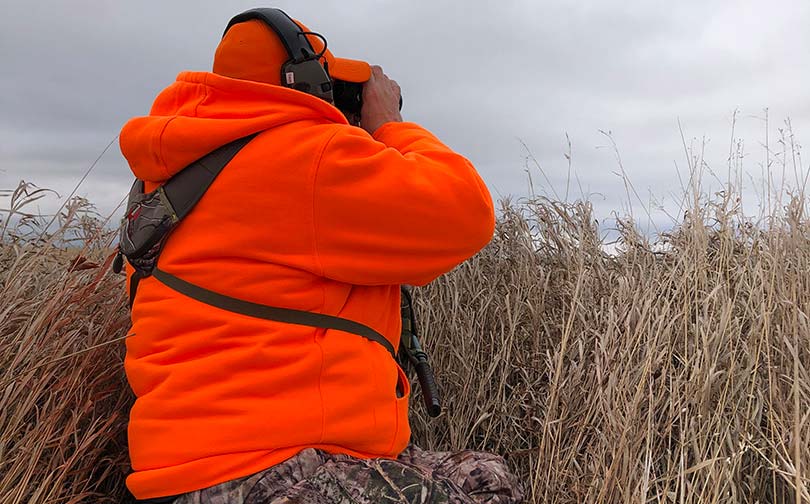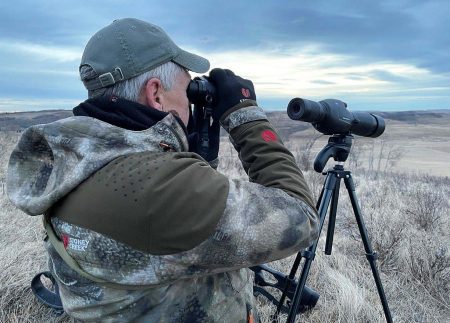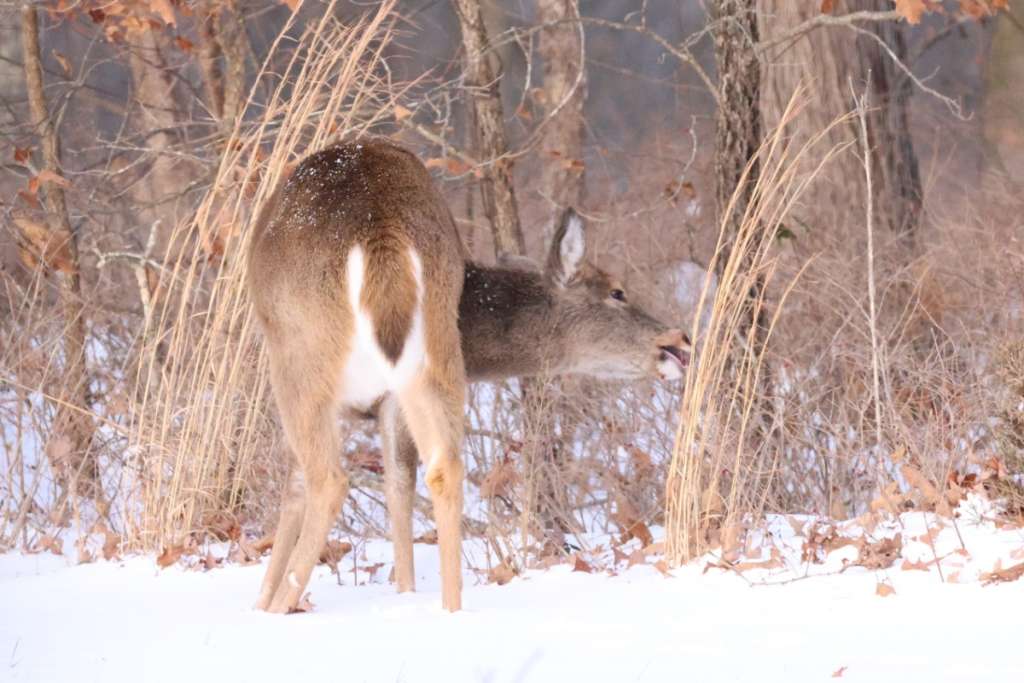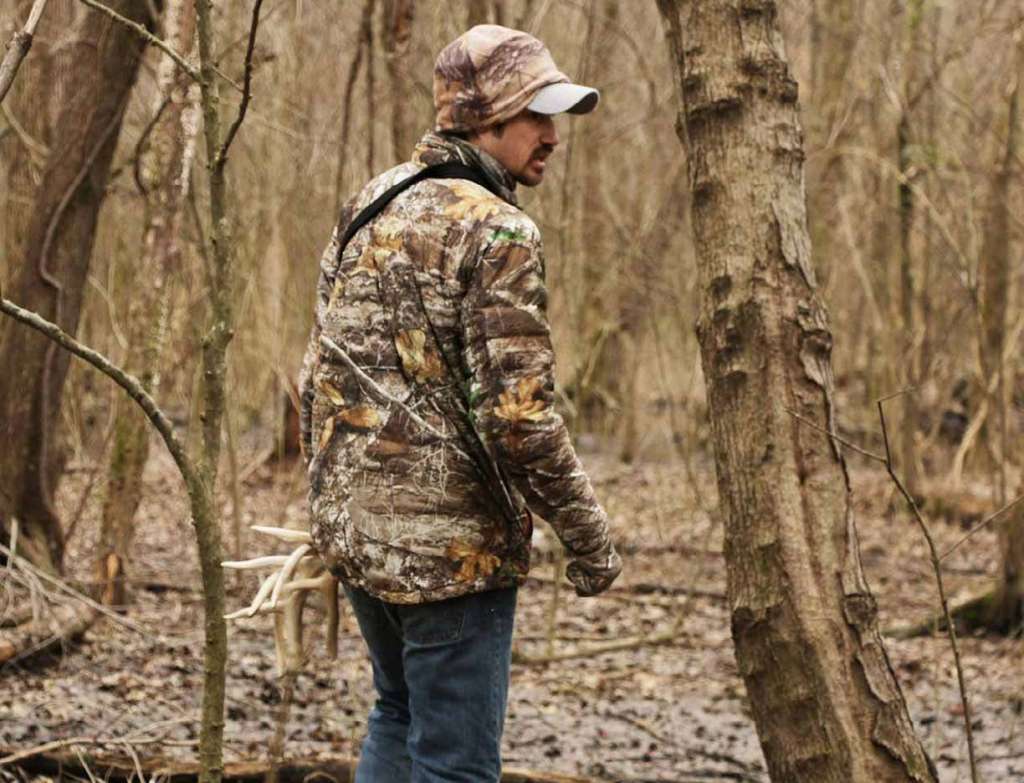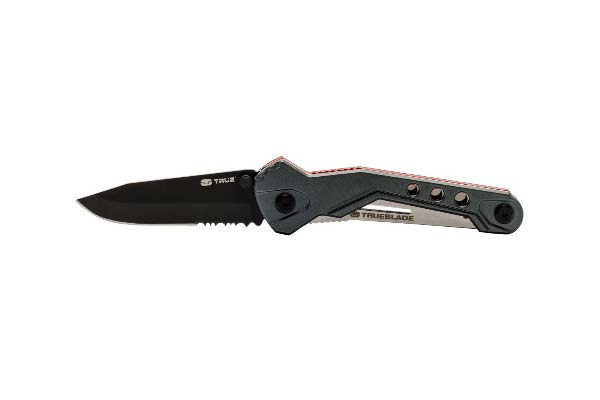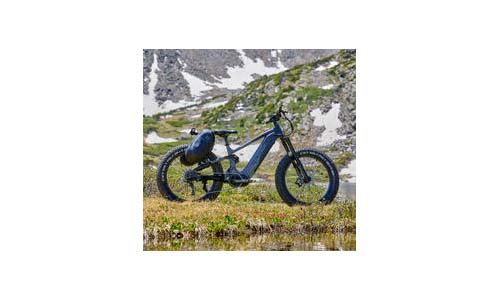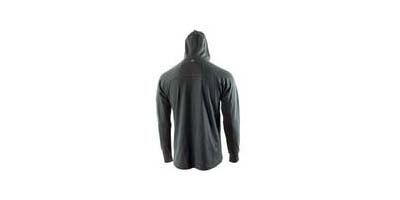A great thing about hunting Whitetail deer is that there are multiple ways to hunt them. Some of my favorite methods for hunting Whitetail deer are calling, pushing bush, and spot-and-stalk. In fact, spot and stalk is my favorite way to hunt Whitetails since it gives me the chance to walk through deer country and see where the deer spend most of their time. I can enjoy the sights and the scenery and get within a comfortable shooting range of the deer, which gives me the best opportunity for a standing broadside shot.
Spot-and-stalk deer hunting can be very effective, especially when Whitetail deer are in the lockdown phase of the rut. During the rut, Whitetail bucks are searching for hot does. Once they find a hot doe and the doe accepts the buck as a partner, the buck will stay with the doe and go to the furthest extent to keep all other bucks away from her.
During this time, Whitetail deer usually find a secluded area like a low spot in a field or a small, wooded area to bed down in while the doe is hot. The buck and doe usually stay together for roughly 24-48 hours. Then the buck will move on and will begin to look for another hot doe to repeat the lockdown. It’s also now that other bucks may come looking for the doe and even challenge the locked-down buck. Because bucks don’t want to lose their does, they aren’t likely to go very far from their does. This can make a spot-and-stalk hunt at this time of year extremely productive and even more exciting if another buck comes along and tries to challenge for the doe during your stalk.
One day during hunting season, I was out hunting with my dad, Mike, and brother, Kyle. Kyle had tagged out the day before, so it was just my dad and I who still had tags. After a quick conversation, we decided that I would get the first shot during the day because my dad had more hunting days planned later in the season. My hunting time was limited with my university finals quick- ly approaching.
It was quite cold and extremely windy that day. We had hunted all morning and not seen many bigger bucks on the move. While having lunch, we figured that the bigger bucks in the area must be locked down with does. After lunch, we decided to change our approach and find some high spots to glass, with the hope of finding a good spot-and-stalk opportunity on a nice buck in lockdown with a doe.
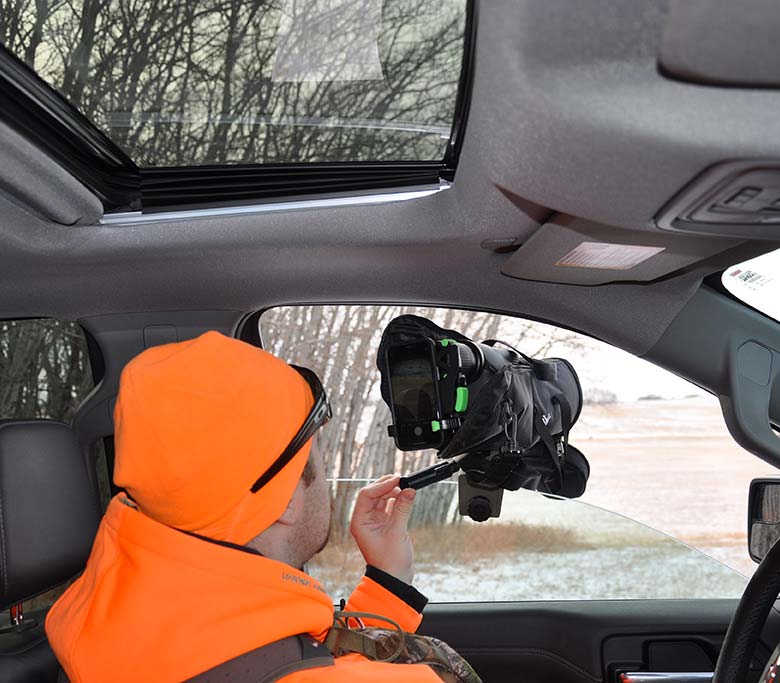
FINDING A FEW
It didn’t take long to find some deer. We spotted a doe, a small buck and a bigger buck in a low spot on the edge of a nearby field. With the naked eye, all we could see were the deer’s heads and antlers. We used our Vor- tex binoculars and Vortex spotting scope to get a better look at the two bucks.
After glassing the two bucks, I decided I would like to try to stalk in and get a better look at the bigger buck. He looked quite nice through my binoculars. Since the deer were bedded down about a half-mile away from the clos- est road, we knew we had a long stalk ahead of us and that we needed to figure out the best approach to move in without getting caught. Since my brother was already tagged out, we decided it was best for him to stay in the truck to watch from afar to limit our chances of getting busted while stalking in. As we tried to figure out a plan, we saw a weedy fence line separating the field where the deer were located and decided that would be the best approach to keeping us hidden while stalking in.
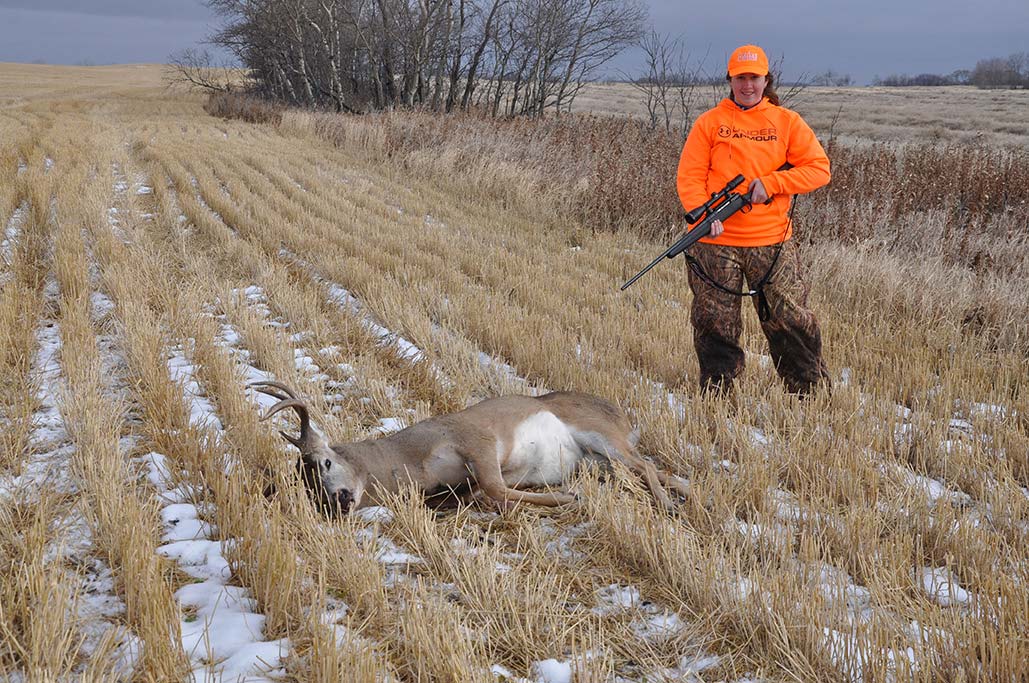
DRESSING FOR WEATHER
I was dressed perfectly to embrace the weather. I was wearing my Woman’s Under Armour Cold Gear base layer and insulated camouflage bibs, orange hoodie and hat. I put on my Buff Neck Gaitor and gloves, grabbed my Savage Axis Rifle and Bog Pod Shooting Sticks, and we started our stalk. At this point I also put on my hearing protection to ensure my ears were protected if I got the opportunity to shoot. In addition, it was easier to wear them than carry them. I prefer the Howard Light Impact Sport Electronic Earmuffs as they are comfort- able, protect my ears when shooting and I can still hear my hunting partners when whispering in the field.
At first, we started walking hunched over single file down the fence line but decided that probably wasn’t the best approach. We thought the deer might be able to see us coming even though the fence line provided some cover. To be sure the deer wouldn’t see us, we choose to crawl on our knees and eventually belly crawl along the back side of the fence line.
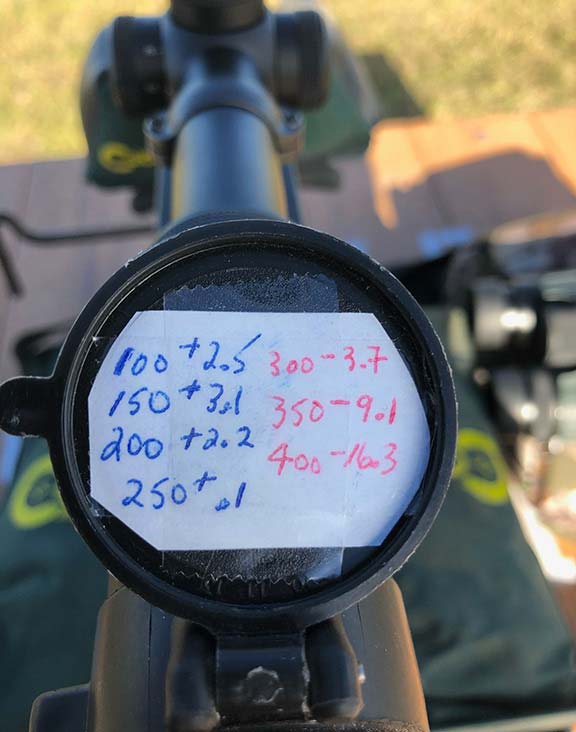
WINDY AND MUDDY
The wind was in our favor, but the strong wind blow- ing directly in our faces was chilling. With this approach we were hoping the deer wouldn’t be able to see or hear us coming. About every 50 feet we would stick our heads up just enough to check that the deer were still bedded down and that we were still on the right track.
The fence line was quite rocky and with little snow, the ground was quite muddy. As we crawled along the fence line, we kept getting poked in our hands and knees by small rocks. By the midpoint of our stalk, our pants were covered in mud. However, this did not stop us from continuing our stalk. What an adventure!
As we crawled along, the grass and weeds along the fence line got shorter and shorter. After about 30 min- utes of crawling, we basically ran out of cover, and we were as close as we were going to get without poten- tially spooking the deer and busting the stalk. I looked through my binoculars and decided that the bigger buck was a good choice. He was a nice thick 4 x 4. He wasn’t a monster, by any means, but with the limited time I had for hunting because of school, he was a perfect mature buck for me to shoot. My dad used his Vortex HD 10X42 Range Finding Binoculars and ranged the deer in at 267 yards.
I instantly looked at the ballistics chart on my scope cover and knew it was going to basically be a dead-on hold as the wind was wind blowing straight at us. Since I was comfortable shooting at this distance, we agreed that we shouldn’t try and get any closer but that we should sit and wait it out.
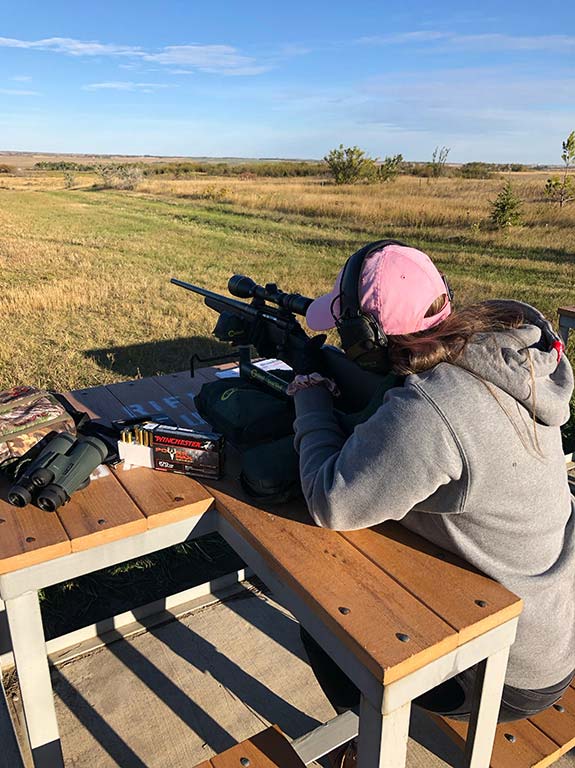
STILL OBLIVIOUS
The deer were still bedded down and had no idea of our presence, so we hunkered down to wait for the big- ger buck to stand up so I would have a clean broadside shot. We didn’t know how long we would have to wait. It was pretty early in the afternoon and the deer might not get up until later in the afternoon to feed or stretch.
My dad had texted my brother Kyle to let him know what was happening and that it might be a while.
While we were waiting, I got my shooting sticks set up for a kneeling shot to keep hidden from the deer, then loaded my gun with 130 grain .270 Winchester Power Max Bonded bullets. This way, I was ready to go when the opportunity came.
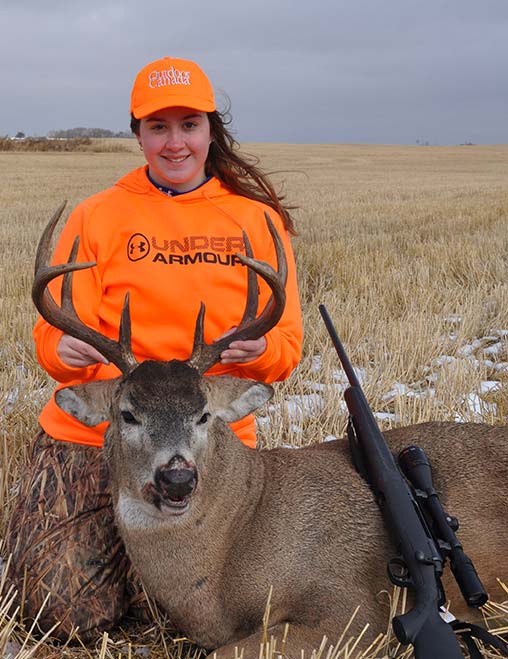
After waiting for about 15 minutes, we spotted a third buck in the distance running towards the bedded deer. As that buck got closer, the smaller buck in the group we’d been watching got up and slowly moved towards the new buck that was about 50 yards away from them. This new buck was smaller than both of the bucks we had been watching, so our focus stayed on the bigger buck that I had already targeted.
The commotion being made by the other bucks caused the bigger buck to stand up to challenge the two others. The doe also stood up and distanced herself from the other bucks. This was the opportunity I was waiting for. As the bigger buck stared down the other bucks, I settled my crosshairs on his chest.
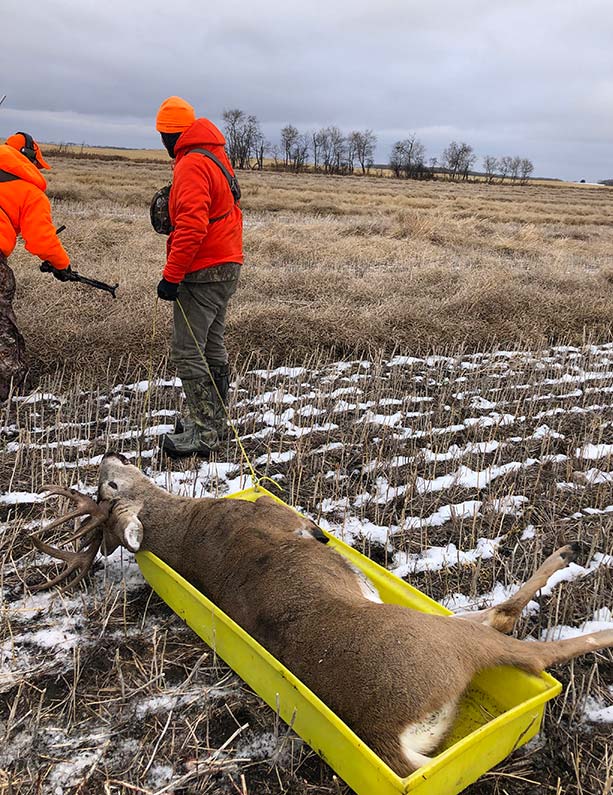
COORDINATING THE SHOT
I confirmed with my dad that I had a clear shot and he told me to shoot whenever I was ready as he had the bigger buck in his binoculars. I slowly squeezed the trigger. At the shot, we saw my target buck’s shoulders hunch up and heard a solid thud, signaling a hit.
I had hit him straight through the chest, but he didn’t go down. Instead, he stood there like nothing had hap- pened. I waited a few moments while the buck contin- ued to stand there, waiting to challenge the other two bucks. At this point, I decided to shoot again and put another bullet straight through his chest. Down he went!
Since the wind was extremely strong, the deer had not heard the shots and could not figure out what had happened to the buck I just shot. They all just stood there trying to figure out what was going on.
Since the big buck did not get back up, the other two smaller bucks focused their attention back to the doe. As we approached my buck, the doe spotted us and took off trotting. The two smaller bucks started following right behind her and were still completely oblivious to us.
We continued walking. When I got to my buck, I approached him from behind and gave him a poke with my gun just to be sure he wasn’t going to get up. At this point, we signaled to my brother (who was watching from the truck) to come see the deer and help us retrieve him. We took some photos, then field-dressed my deer, hung him up and skinned him using our truck hitch skinning pole and some Outdoor Edge RazorMax knives. As a final task, we wrapped my deer in cheesecloth to keep the meat clean and dry for the rest of our hunting trip.
With all the field dressing chores done, we loaded my buck into the back of the truck and off we went.
We wanted to try to find my dad a buck, since we still had two hours of legal hunting time left in the day. That seemed like plenty of time for another spot-and-stalk hunt.
Oh, what a thrill spot-and-stalk Whitetail deer hunting can be! I’m already dreaming of next hunting season and hoping for a similar opportunity on an even bigger buck.
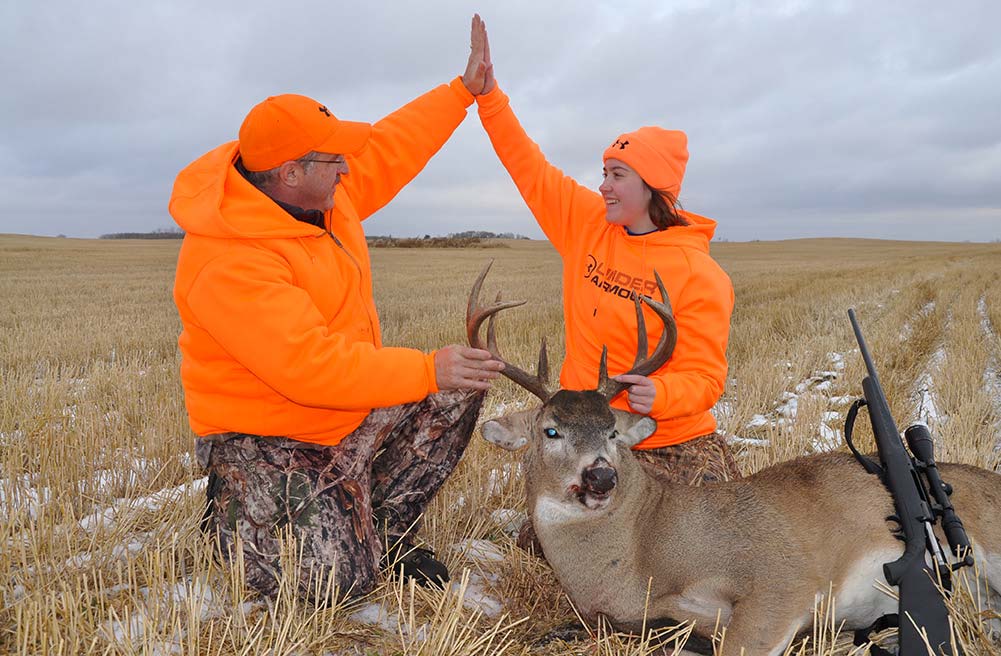
Per our affiliate disclosure, we may earn revenue from the products available on this page. To learn more about how we test gear, click here.






